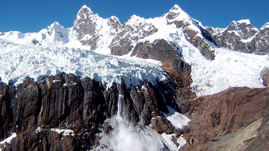Teachers' Domain - Digital Media for the Classroom and Professional Development
User: Preview

Source: ThinkTV
How can glaciers exist in the tropics? This video by ThinkTV takes us to the high altitude glaciers in the Andes of Peru and explains that glaciers can exist even at tropical latitudes. Learn how the glaciers are formed, and how glaciers in the southern hemisphere differ from glaciers in the northern hemisphere. See the evidence of shrinking glaciers and learn how scientists are trying to relate this evidence to the patterns of change in other glaciers around the world.
Glaciers in the tropics provide a detailed record of climate change over time. In tropical glaciers, ice deposited during the rainy season alternates with dust blown onto the ice during the dry season, providing a yearly record of the climate. When scientists examine ice cores, or cylinders of ice drilled out of glaciers, they can study the history of climate dating back thousands of years. They determine rainfall patterns by studying the net ice accumulation; drought patterns and the dustiness of the atmosphere by studying dust layers; and vegetation changes by studying pollen. Scientists can even determine the composition of ancient air by studying trapped air bubbles. They also study past temperatures, volcanic history, human-caused emissions, and trapped microorganisms Scientists are able to date the ice layers by matching volcanic dust layers with recorded volcanic eruptions and, for more recent years, by matching radioactive fallout with bomb test dates.
Scientists study how far glaciers extended in the past by dating moraines, the rubble left behind by a retreating glacier. Methods used to date moraine deposits include measuring beryllium 10, studying how glaciers sorted pebbles by size, and by studying lichen growth on rocks.
During the 1970s, Dr. Lonnie Thompson, from Byrd Polar Research Center (BPRC), was the first scientist to retrieve ice samples from tropical ice to analyze for ancient climate signals. Dr. Thompson and other scientists from BPRC have been monitoring tropical glacier loss since that first visit. Glaciers in the Andes Mountains have lost at least 22% of their glacier area since 1970; the Quelccaya Ice Cap, the largest ice cap in the Peruvian Andes, has shrunk by 30% in the last 33 years; and the Broggi Glacier, located atop Cordillera Blanca—the largest glacier chain in the tropics—has completely disappeared. Qori Kalis Glacier is retreating 155 meters (509 feet) per year, three times faster than between 1995 and 1998. The melting ice has formed a large lake over 60 meters (200 ft) deep and covering more than 10 acres in front of the glacier since 1983. Because understanding dynamics of local climate variability promote understand global climate dynamics, scientists from BPRC collected ice in July 2010, from Indonesia's Puncak Jaya, the only glacier in the tropical Pacific. Studying ice data from Peru, the Himalayas, and Indonesia will help scientists understand how shifting weather patterns can alter the Earth's climate.
Here are suggested ways to engage students with this video and with activities related to this topic.
 Loading Standards
Loading Standards